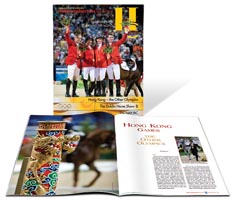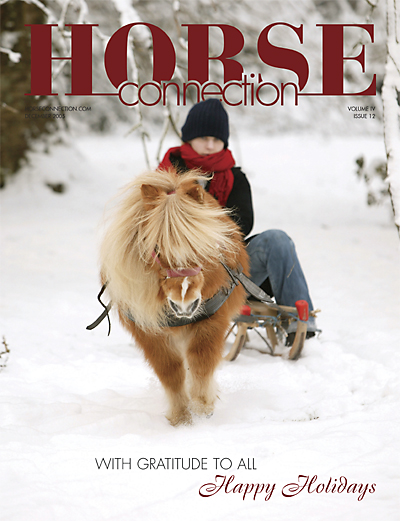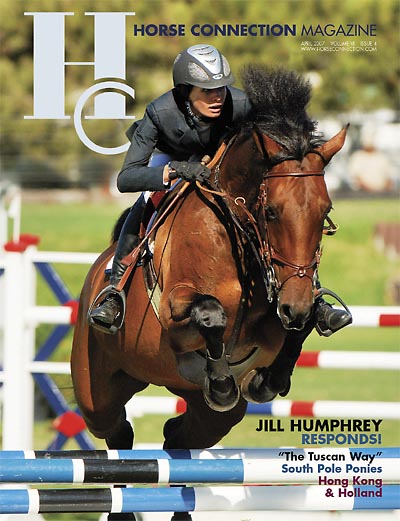
The Tuscan Way – April 2007

geoff young
All photos by Geoff Young
Palio delle Contrade photos by Tamara Sorley
The sound of hooves approaching on the road meant a king was traveling…or soldiers were coming. On this ancient road, through the gentle hills of the Val D’Orcia valley, you could see the horsehair crest on the bronze helmet rise up from the road, followed by a Roman soldier.
A mule carrying a man and his son moved to one side of the road. The rest of the travelers, all on foot, slowly shuffled a parting through which the horses with their shining riders passed.
I moved my horse to the edge of the stone bridge, built 200 years before Christ, and watched as the procession of people continued their pilgrimage towards the holy city of Rome.
I blinked, and two thousand years passed. I was on horseback riding the ancient Francigena Road in Tuscany, following a road of our origins, and discovering a spiritual connection to history, and ancient humans and their horses as we traveled this historic road
of pilgrimage.
My wife Valerie and I arrived in Florence with our host, Tamara Sorley, the program director for “Destination Everything Italian!” Tamara, from the U.S., and her Italian partner Vittorio Cambria, have put together a travel program that encompasses a real taste of the “Tuscan Way,” from horseback adventures to cooking classes, wine tasting, city strolling and spa indulgences, and food, glorious Italian food.
What Tamara and Vittorio have created is an all-inclusive week that will cater to your every need regardless of what you want to do. What we came to do was ride horses, drink wine, eat food, and experience a Tuscan way of life that is slowly disappearing.
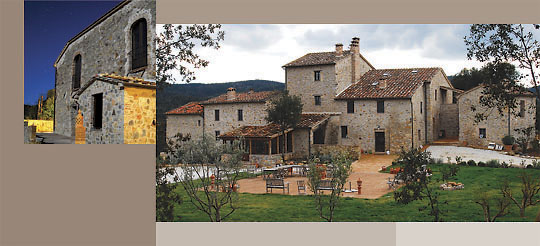
La Nostra Sede Italiana (Our Italian Home)
Vittorio picked us up at the airport, and after a stop at Gelateria Badiani for an espresso and a dish of Florence’s finest gelato, we headed south towards Siena and on to Borgo di Ferraia (Iron Hamlet), Vittorio’s renovated 12th century villa that would be our home for the next week. Named for the iron that was mined in this area during medieval times, Ferraia, which dates back to 1204, was inhabited until the start of World War II. From then on it fell into ruin until 1995, when Vittorio began acquiring the hamlet.
Vittorio is passionate about preserving the history and feel of this area, and so he undertook what has now been a ten-year mission to renovate the hamlet, staying true to the materials of stone and wood that were originally used. The results are stunning.
Ferraia now has accommodations for as many as 30 guests in lovely bedrooms with whitewashed walls, stone tiled floors, and beam and tile ceilings. The large soaking tub with jets in our room was the perfect balm after a day of riding.
Several of the bedrooms connect to a common area that features a fireplace, comfortable furniture, and a cabinet filled with wonderful Tuscan wine for guests to enjoy, which we certainly did.
A stroll around the grounds of Ferraia will bring the discovery of a beautiful infinity pool that overlooks the mountains and valley. Under the huge stone terrace are saunas and hot tubs that will rid you of the last bit of stress remaining from your previous life, from here on known as BT (before Tuscany). It is so peaceful here that you feel transported not only to another country, but another time; a time that Vittorio is determined to preserve.
Upon our arrival from the airport, we unloaded and met for a welcoming glass of fine Tuscan red, a hint of wonderful things to come. We sat down to a simmering bowl of fresh vegetable soup, with the ingredients coming from the villa’s own garden and greenhouse. The fresh factor is the top priority of the food served at Ferraia. It is organic, fresh, and invigorating from dish to dish. This focus on fresh and wholesome food is prevalent throughout Tuscany. Good food makes you feel good, and I felt out of this world by the time I had finished the spinach stuffed veal. My life BT (before Tuscany, remember?) was fading fast as I slipped under the comforter with the light of a Tuscan moon shining through the window.
A sunny blue sky greeted us at breakfast as we sipped cappuccinos and ate fresh fruit, organic eggs, home baked breads and cakes. Feeling fortified, we headed down the road to Vittorio’s farm La Ripa, where his herd of 30 well-kept horses reside in British-style shedrow stables with pastures. Seven well turned-out horses waited patiently for us, as did Chiara, Vittorio’s head trainer and riding guide. Chiara was enthusiastic and charming, and had done her homework in matching us up with our horses. I was given Rita, a beautiful Maremmano.
It is believed that the Maremmano is a descendant of the Neapolitan horse. Maremmanos are bred in Tuscany, and are the traditional horse of the cattlemen (butteri). Maremmanos combine a lively temperament with strength and toughness, making them a good, sure-footed working horse. The Maremmano is an important part of the equestrian tradition in Tuscany.
The other horse breeds represented at the farm include Lipizzaners, which Tamara rode, Anglo-Arab crosses on which Valerie sat astride, and Sicilian horses. Chiara and another staffer, Francesco, had them tacked up and ready for a quick spin in the round pen to make sure horse and rider were a good fit. We rode in english saddles, but they have western and australian saddles for those preferences as well.
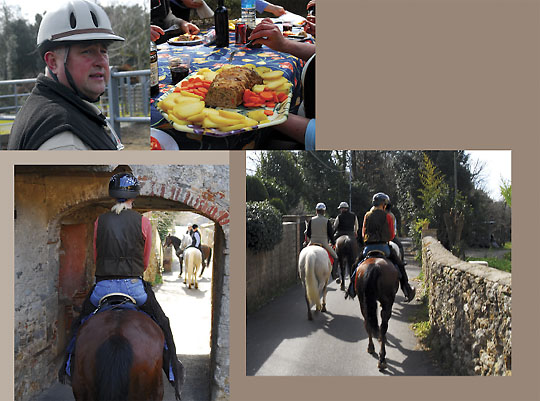
Andiamo! (Let’s go)
With Vittorio leading the way, we rode out into the beautiful surrounding forest of chestnut trees, pines, and cork trees, many of which were stripped of their bark, in order to seal the bottles of the many wines produced in the region. Narrow roads took us through small medieval villages perched on hills with surrounding walls, the better to defend against invaders. From the villages we would ride back into the forest, down across streams, and up onto vistas of the valley and the hills.
Around midday, we came upon a table in a clearing that was set up for a forest feast. We tied up the horses and headed over to indulge ourselves with homemade meatloaf with carrots, potatoes, and stuffed tomatoes. There were jars of eggplant and salted sun-dried tomatoes in olive oil in which to season the potatoes, and bottles of wine to wash it all down.
Powered by this epicurean epiphany, we continued riding the rest of the afternoon, enjoying the peace of the countryside, and getting the adrenaline going with a few spirited canters through the woods. If my horse Rita is an example of the Maremmano, it is a fine breed of horse.
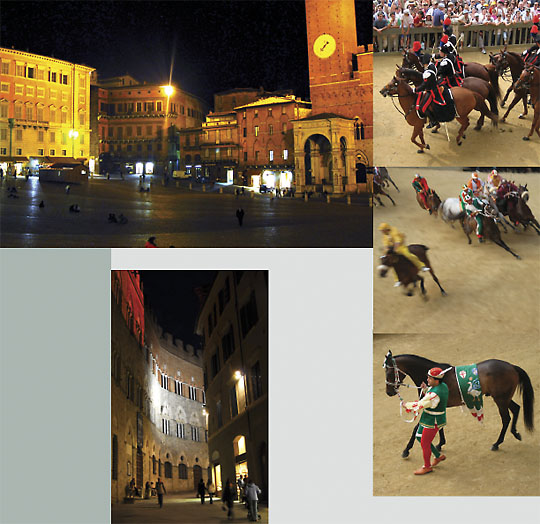
Siena Bello (Beautiful Siena)
After our ride we headed towards Siena, a half-hour away, for a walking tour with Federica Olla, our knowledgeable and friendly guide.
We walked by the Piazza del Campo, considered by many to be the loveliest plaza in Italy. It is here that the Palio delle Contrade is held twice annually on July 2nd, and August 16th, even though the festivities go on for weeks. It is Tuscany’s most celebrated festival and one of the most harrowing horse races in the world. First ran in 1283, the Palio is a break-neck, bareback horse race around the plaza. The jockeys each represent one of the 17 fiercely competitive contrade, or districts of Siena. Horses and racing positions are determined by lottery, and the race is preceded by four hours of pageantry with each contrade parading their flag and colors. Thousands of people jam into the middle of the plaza and fill the balconies from above. Three laps and 90 seconds of frenzy make this a must-see spectacle
We said farewell (ciao’ ciao’) to Federica and found a table at Trattoria da Gano. Another splendid meal was served with a first course of pasta followed by gnocchi with wild boar and rabbit with artichokes. It was the perfecto’ ending to our first day in Tuscany. But, it wasn’t over quite yet.
On the way back to Ferraia, Vittorio asked us if we were ready for some wild boar hunting. What are you going to say? “No thank you, I have had enough excitement for one day?” I don’t think so. With an affirmative nod, Vittoria turned the van off the road and into the darkness where, brandishing a spotlight in one hand, proceeded to drive all over the field chasing herds of wild boar. I’ve got to hand it to Vittorio, he really gives you an authentic taste of the Tuscan life, and it couldn’t be more entertaining!

Guidando Nelle Ombre di Etruscan (Riding in Etruscan Shadows)
After another scrumptious breakfast, we headed out to ride as guests, courtesy of the Siena Tourism Board, Director, Fiorenza Guerranti, and the Cavalieri Senesi, a local riding school that offers riding tours to the monastery of Lecceto and the surrounding area. Our guide, Laura Pela, along with her friend, Giorgio, took us out for a wonderful ride through woods, along vineyards and villages, to the monastery. As we got near our destination, religious frescos, painted in small little chapels lined the trail. A herd of Haflingers ran up from their pasture to greet us as we gazed out at the beautiful gardens and villas.
A mist hung in the air giving everything a dreamy look. As we rode through the woods we came upon an ancient Etruscan altar. Still visible is the large circle of stones, and what was left of the altar. The Etruscans remain one of the enigmas of history. This civilization dominated central Italy for 800 years until the Romans obliterated it during the second century BC. The Etruscans have never been given credit for their accomplishments. The Romans learned road building, hydraulics, and surveying from them. They developed the canal system, developed the temple architecture made famous by the Greeks, and are considered the first society to sculpt figures in clay with human features. The Etruscans’ demise may be partly attributed to their ephemeral attitude towards life on earth, which led them to build their homes of wood and clay. On the other hand, the altars and tombs were built to last forever.
We returned to the riding center and met with the president of the Cavalieri Senesi, Marco Fedi, who treated us to a lunch of grilled meats, bread and wine. Food tastes even better when you’ve worked up an appetite on a horse!
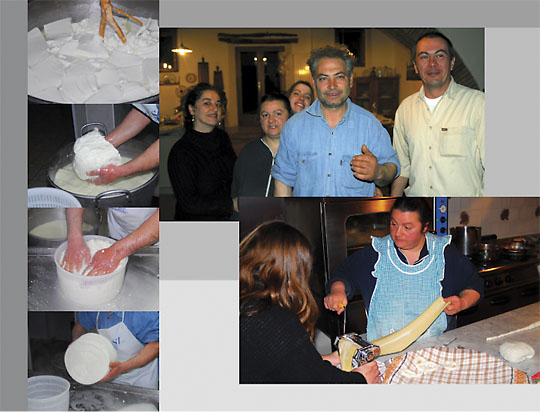
Grazie per la Serata (Thanks for the Evening)
The culinary highlight of our day was ahead of us as we drove to Radicondoli, and the sensational pecorina cheeses at Podere Paugnano, made by Giovanni and Giovanna Porcu.
Giovanni milks 100 sheep every day himself to make the pecorino cheese. A large kettle of sheep milk was warming on a burner as Giovanni constantly checked the temprature of the milk before adding the enzymes or rennet. While the enzymes did their work on the milk, we went into the house for some cheese tasting.
While Giovanna was busy in the kitchen making dinner, we sat around the large table and sampled the pecorino, starting with a very young cheese and working our way up to a wheel that was 16 months old. It was fabulous at any age.
In under an hour, the rennet had transformed the kettle of milk to a yogurt like consistency. Giovanni, using a forked stick, stirred up the mixture and then plunged into the milk up to his elbows to start working the cheese together. After several minutes he brought up a big clump of curdled milk. He then placed it in a strainer and started to press out the liquid with strong hands and arms. Soon, the cheese had taken shape and we sampled a bit of it right out of the kettle. It was delicate, sweet and earthy. I looked over and saw Vittorio putting the milk runoff on his hands and face! He encouraged us to do the same and after rinsing it off, my skin felt as soft as the homemade raviolis that Giovanna was making. Vittorio plans to bottle this milk and make it available at his spa back at Ferraia, as a healthy, organic beauty supplement. This man is really on to something.
The first course at dinner was incredible. Soft, finger sized ravioli filled with fresh cheese and covered in a fresh tomato sauce. I could have sat there and ate them until I burst, but I detected the whiff of fresh roasted lamb, and since that is one of my all time favorite meats, I declined third helpings of the ravioli.
The lamb was out of this world, but actually it was from the pasture just out the door. It was so flavorful, no doubt from the way it is raised, organically and free grazed.
We sat around the table listening to the family talk with each other and Vittorio, who translated enough of the conversation to make us feel included. Expressions on a face can replace language in communication, and with all of the smiling back and forth, and the nods, we got along famously.
We finished off the meal with an aperitif, hugged Giovanna and Giovanni, and left the warm hospitality of this Italian family. Breaking bread with people of other cultures, and languages, is a way to reaffirm the bonds we share as people. Some just have better food than others.
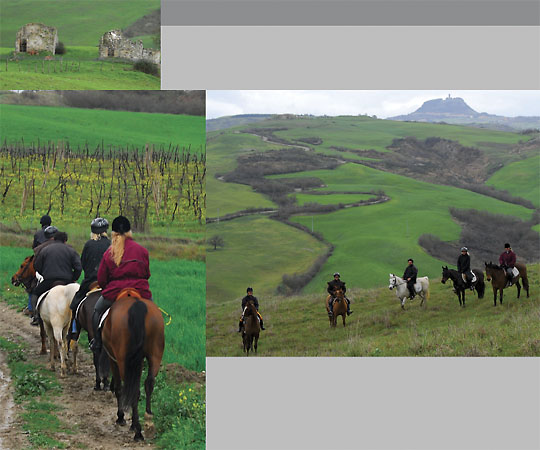
Olio Antico di Oliva e di Hoofprints (Ancient Hoofprints and Olive Oil)
Overcast skies and misting rain shrouded the green hills, and for a moment I thought I was in Ireland, instead of an hour’s drive northwest to the fascinating clay hills of Siena. The landscape had changed so dramatically from the forests of the Merse Valley to these gentle hills of the Val D’Orcia valley unfolding toward Mt. Amiata, and the tower of Ghino di Tacco’s castle.
The Tourism Board had scheduled a ride for us through theses hills, courtesy of Enrica and her beautiful holiday farm, II Poggio. The horses at II Poggio were beautifully turned out for us with a fine selection of Arab and Italian saddle horses. Enrica led us down the road, heading towards the floor of this green valley with its rugged gullies, wheat fields, vineyards, and ruins scattered throughout the rare beauty of this landscape.
After crossing a rain-swollen stream, we rode up the valley a short distance and headed up another road to the upper reaches of the valley. As we climbed, the expanse of the land revealed itself. The Orcia valley was strategic in terms of defense back in medieval times, and from our position, one could see an army approaching from quite some distance.
The Road Francigena appears to be nothing more than a muddy dirt road winding its way along this high point in the valley, but the ancient imbedded road stones tell another story. This was the medieval road of the pilgrims toward Rome and the Jubilees, a road crossed by merchants, pilgrims, kings and armies. At the end of 1000 AD, it was used by knights and Crusaders coming from the “ultra Alps” to regain the Saint Sepulchre. This trip towards the tomb of the apostles Pietro (Peter) and Paul united the rich man to the poor man, the prelate to the pilgrim.
As we crossed that 2,000 year-old Roman bridge, on this road that became the most important European road of the middle ages, I stopped my horse. I sat there like a king might have, because usually the most powerful and prestigious people of those times would travel this road by horse. Fortunate people would cross by mule, but most did it on foot. I saw some stone ruins not far from the bridge. It was probably an ancient tavern or inn that refreshed the pilgrims along their way, offering them a roof over their head, some straw to sleep on, and sometimes a frugal meal.
This “Road of Faith” was an authentic adventure, studded with traps, dangers, and natural obstacles, but it was regarded as a walk of purification, as well as a walk of spiritual discovery. Through all of the centuries past, it still is. I felt it to my core – the snorting of my horse, the intact stone sides of this bridge of Roman epoch, the time past and the time ahead, the here and now, and the forever. We still travel by foot and by horse, making time stand still.
After the ride, Enrica treated us to a sumptuous spread in the restaurant of the main house of II Poggio. The farm produces all of it’s own vegetables, herbs, wines, and olive oil. We dined on bruchettas, an incredible jet-black tempura ball stuffed with white fish, the color of which came from squid ink, fresh pasta, and prime beef. The II Poggio olive oil was so good, I was pouring it over everything.
Like Italian food, Italian olive oil is distinguishable by region. Oils from Tuscany are considered the benchmark. Because olives for classic Tuscan oils are picked before they’re completely ripe, they have grassy, artichoke, and Sauvignon Blanc flavors. It was impossible to leave without purchasing a couple of bottles.
We relaxed later that evening back at Borgo di Ferriai, around the fireplace, eating cheese, drinking wine, and telling stories, much the same way as the pilgrims would have done after a day of travel.
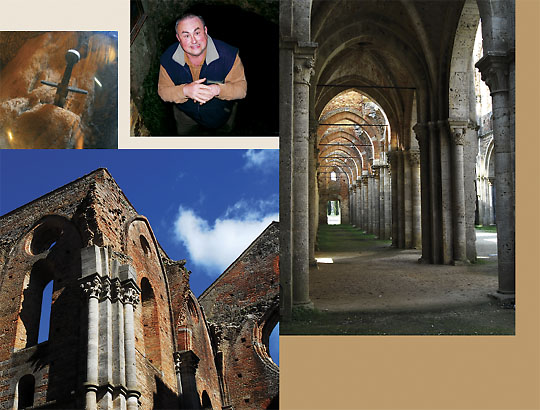
Una Spada Nella Pietra (A Sword in the Stone)
We took a morning ride through the forests of the Merse Valley and after lunch we visited Castello di Tocchi, a medieval village dating from 1100. The ancient fortress walls and the magnificent arch remain intact. The road makes a sharp turn to the right as it enters the keyhole entrance to this village. This prevented invaders from being able to line up a long battering ram to penetrate the doors. Just minutes from Ferraia, Vittorio has apartments in Castello that can be rented by guests for the week. The most intriguing aspect of Castello is the Etruscan tomb, dating back to the 4th century BC, which lies below the center of the village. This huge underground room, carved into the stone, held the dead and all of their belongings.
That evening, we participated in the popular and widely known La Cucina del Castello Culinary School. The cooking classes are now held in the spacious kitchen of Villa Ferraia instead of the original location at Castello di Tocchi. Stefano, the chef and caretaker of the organic garden invited us down the path to gather the fresh ingredients for the evening’s meal. We filled a basket with kale (or black cabbage as they call it), parsley, leeks, and some flowers. We would be preparing a leek cake, fresh pasta with pesto, and a chestnut cake for desert. Stephano was a great teacher and he put up with our antics and laughter. With a few noodles tossed here and stuck there, it was a real hands-on meal experience.
Our last day at Ferraia began with a spirited ride through the gorgeous countryside that included a visit to the rural village of Monticiano, and then on to the jaw-dropping San Galgano Abbey and the Chapel on Mount Siepi, where we picnicked in the shadows of the roofless abbey. After dining on black olive pizza and garbanzo bean soup, we explored the 12th century San Galgano, which was one of the most important Italian monasteries. It is a magnificent example of gothic Cistercian architecture, with stone and marble arches and columns reaching to the sky.
Across from San Galgano Abbey is the Church of Mountesiepi, where the knight Galgano Guidotti lived and died as a hermit, and then became a saint. Inside the chapel under glass is the rock that holds the sword, buried up to it’s hilt to form a cross, that Galgano plunged into the stone to renounce his earthly bonds.
Winding our way off Mount Siepi, through the long columns of cypress trees, there was time for one last adventure, one last taste of the Tuscan Way.
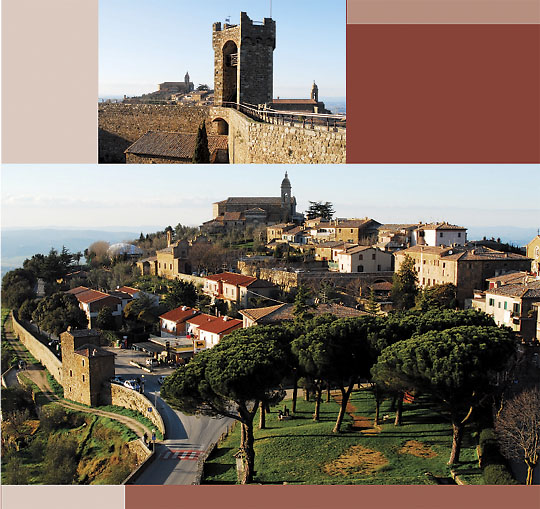
Alzi un Vetro in Toscana (Raise a Glass to Tuscany)
The history of Italian wine is the history of Italy. The ancient Greeks called the peninsula oenotria-the land of trained vines. During the Renaissance, Tuscan wines achieved the preeminence they still enjoy today, in terms of quality, ageability and price. Although Tuscany is a major center of experimentation in Italian winemaking, it remains a headquarters for Italian classic reds, all based on the Sangiovese grape. Their other common theme is that all are oak aged by law, although the minimum oak-aging time varies. The Brunello is the longest aged of all the Tuscan reds.
Biondi-Santi, one of the most famous wineries and wine families, is credited with inventing this wine because they were the first to isolate the Brunello, an especially high quality version of the Sangiovese grape. The small growing area surrounds the hilltop town of Montalcino, southwest of Siena.
Montalcino, which dates back to the Etruscan period, was never conquered, despite many invasions. Sitting high on the Francigena road, it took on the structure of a military city with a huge fortress spouting numerous towers and large fortified walls. The town is famous worldwide for it’s Brunello wines, one of the few Italian reds to be granted the DOCG certification.
A wine tasting was arranged for us at the wine shop in the fortress, Enoteca “La Fortezza,” where we sat at a long table with three labeled glasses set in front of each of us. We sampled the Rosso di Montalcino, the Brunello di Montalcino, and the Brunello di Montalcino Riserva. We tried each wine on its own, and with bread and cheese. Rosso di Montalcino is baby Brunello, a good wine to drink while you are waiting for the real thing to age in the cellar. The Riserva is a big wine – your nose can feel the alcohol vapors – and the spiciness is quite pronounced. The Brunello di Montalcino was my favorite. This is serious vino with richer and riper fruit smell, more towards plum or even dried fruits like prunes. The body and tannin are dominant, and if one could wait, this wine would only get better with age.
I stood at the highest point of the fortress and looked out at the setting sun as it suffused Montalcino and the Orcia valley in a Tuscan bronze. This was the last sunset I would see in Tuscany for some time, and I lingered, soaking up the air and the light, still tasting the essence of Brunello, and feeling like a very old soul.
Our last night at Borgo di Ferraia would be a culinary finale, starring steak Florentine cooked over wood coals with a little olive oil, salt, and pepper. The elegance of this dish was in the simplicity – it is the key to preparing food that is this fresh – and was the magnificent final aria to a weeklong symphony of cuisine and culture.
Vittorio Cambria, through his passion and vision, has preserved a cultural experience that will leave an imprint on those who take the journey into a way of life that embraces the simple pleasures of living. Riding horses on the ancient Francigena road is an experience that Valerie and I will never forget. And when someone asks me what the people are like, I will tell them about the wonderful evening we spent in the home of Giovanni and Giovanna, eating his handmade pecorino cheese and dining on her roasted lamb at the family table.
Our week in Tuscany was an equestrian’s dream. You can ride the countryside, through ancient villages and alongside ancient ruins, and can sample food and wine that has made this region legendary. And if you’re lucky, your horse will take you to places you never imagined. Who knows, you may ride back over two thousand years. It’s the Tuscan Way.
Contacts:
Destination Everything Italian! www.destinationeverythingitalian.com
Tamara Sorley – Program Director – 303-885-9995
email: tsorley@peoplepc.com
Tourist information: www.terresiena.it email: infoaptsiena@terresiena.it
II Poggio – www.ilpoggio.net

